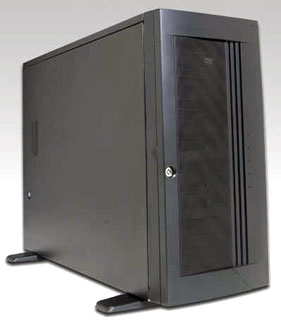Systemax Endeavor Xeon Workstation
Introduction and Specifications

As gamers and hardware enthusiasts, it’s easy to get jaded by Extreme Edition processors and multi-card CrossFire configurations. They push performance full-bore. And although you’ll never hear AMD, Intel, or NVIDIA recommending against using their enthusiast offerings in higher-end configurations, there’s no denying that Xeons, Opterons, Quadros, and FireGLs belong to a different pedigree. It’s The Hamptons versus South Beach. You can’t go wrong either way, but there is a distinct difference.
So when it comes time to pass judgment over workstation-class hardware, you might be tempted to turn your nose up at a list of stuffy-sounding specs. A quad-core Xeon running at under 2 GHz? Two gigs of system memory? A single-slot graphics card with a 128-bit memory bus? Are we kidding here? Ah, but check out the uptime. Bet you can’t get one of those boxes to crash, even under full load. Sure, servers and workstations prioritize performance, but there are other metrics used to determine if a critical machine passes muster.
Systemax recently sent over one of its Endeavor workstations, featuring a long list of those high-end parts that gamers might otherwise once-over. The business-class folks, on the other hand, will be much more likely eat up the machine’s build quality, its composition, and—hopefully, after our battery of tests—its dependability.
Processor GPUs Memory Motherboard Power Installed Drives: Price PC Health Monitoring Onboard I/O
The Systemax workstation arrived in an unassuming brown cardboard box to match the system’s “we mean business” spec sheet. Everything was packed away neatly. The workstation itself was wrapped in a large plastic bag and cushioned on each side by foam bracers. A single box resting on top of the machine held all of the accessories together—everything from PNY’s component output breakout box (bundled with the Quadro FX) to instruction manuals, cables, adapters, and driver disks. Systemax’s price as configured is listed at $2,499—a significant chunk of change for a mid-range workstation. However, consider that the Endeavor doesn’t consist of desktop hardware packaged into a business-class façade. This is a Xeon processor on a Supermicro motherboard loaded down with FB-DIMM memory and a professional graphics card. Presumably, what you lose in raw muscle, you gain in finesse. You're paying for the hours of testing and specialized driver development that goes into validating each piece of hardware in a production environment. Like so many other system builders out there, Systemax does business through its Web site at systemaxpc.com. Our initial concern was that, after one month with the workstation, Systemax hadn't yet updated the site with information on its Intel-based Endeavors (originally, Systemax sold the workstation with AMD's Opteron CPU). You would have needed to call the company's toll-free number to place an order. Recently, however, Systemax added the Intel platform to its online configuration tool, making it possible to build this exact system we test here online and place the order.
![]()
Systemax Endeavor Workstation
Specifications and Features








